SOC Students Deliver DC News to Colorado
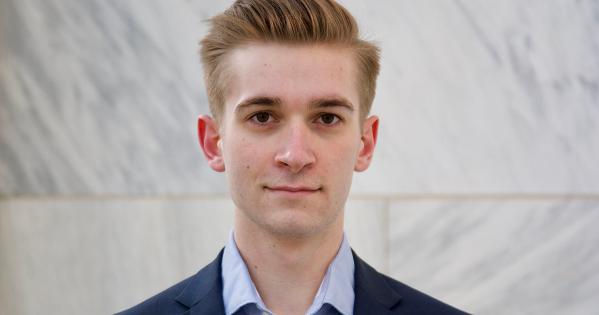
May 1, 2011, fell on a Sunday, and Karen Frantz was in her apartment in Washington when President Barack Obama stood at a lectern in the White House in front of television cameras. At 11:45 p.m., Obama announced to the nation that a team of Navy Seals killed Osama bin Laden, the founder of al-Qaida, in Pakistan, almost 10 years after the 9/11 attacks.
Frantz, a journalism student at American University’s School of Communication (AU SOC) and an intern for the Durango Herald (Colorado) during that spring semester, watched and listened to Obama. Then she grabbed her video camera and phone and headed to Lafayette Square across from the White House, where she figured people would be gathering.
The temperature that cloudy night in Washington hovered at 58 degrees, and by the time she arrived hundreds of people had gathered. Frantz set about recording the scene and getting people’s reactions.
People were chanting “Yes We Did” as they mingled shoulder-to-shoulder. Others climbed trees and were chanting “USA, USA.” One man waved an American flag. Another climbed a light pole where he, too, waved an American flag. Cars filled the streets as drivers honked their horns. Frantz captured all of that, then hurried back to her apartment to send the video to the Herald. The newspaper had it posted on its website before the Associated Press had sent its video. She followed up the next day with reaction from Mark Udall, then Colorado’s Democratic senior senator, Michael Bennet, then Colorado’s junior Democratic senator, and Scott Tipton, then the Republican representative from Colorado’s 3rd congressional district. Frantz was asked to extend her internship into the summer.
After earning her master’s degree in Journalism and Public Affairs, Frantz was assistant editor and community manager for New York International, a trade and development company. She next was reporter for the Times Ledger Newspapers in Queens, New York, covering politics, public policy, the environment, crime, business and education. She later was an environment and energy reporter for Exchange Monitor Publications in Washington, D.C. Frantz then worked as a freelance editor. Currently, Frantz is taking a sabbatical from journalism to be a mom to her two young kids and a caretaker for ailing family members.
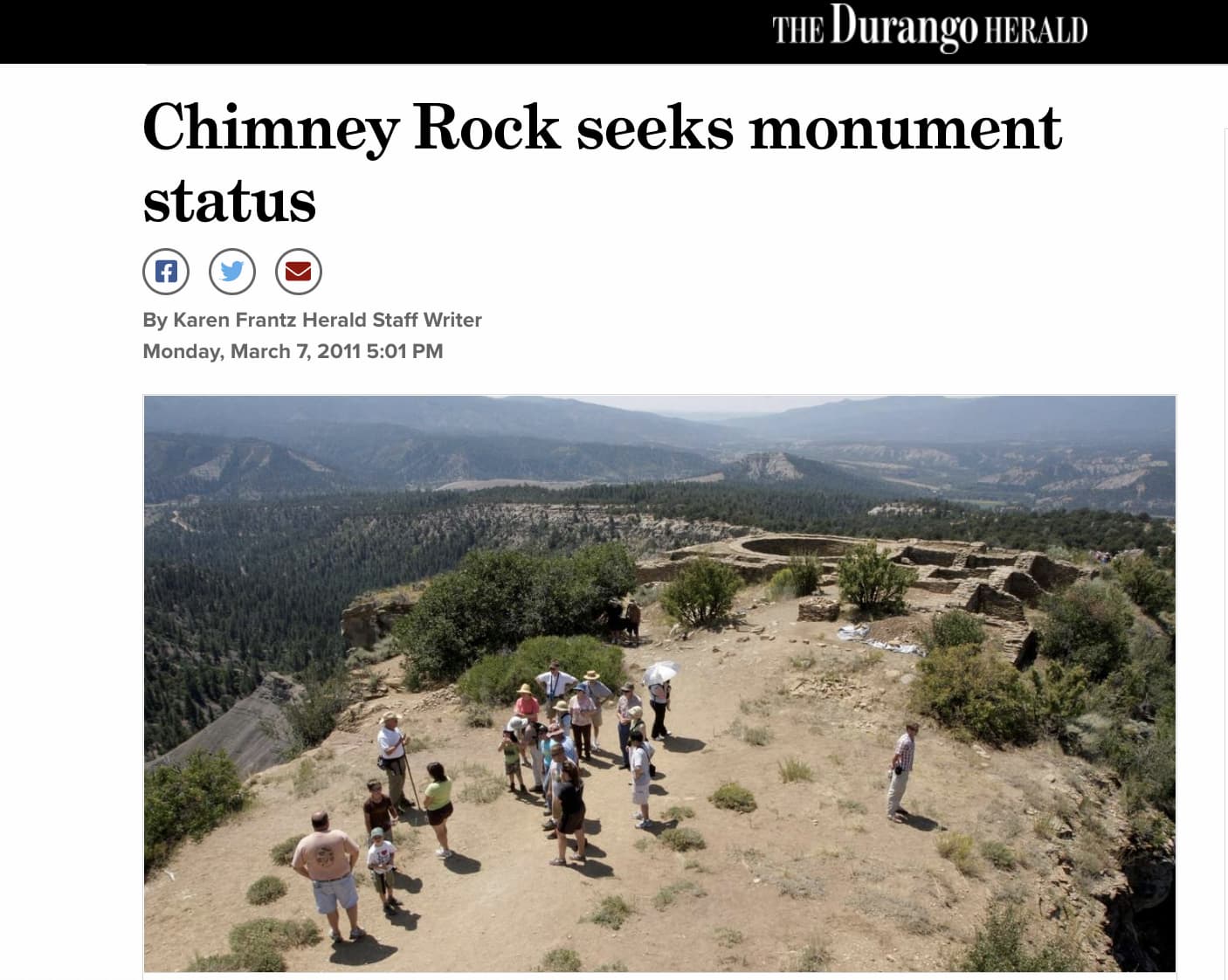
Nearly two years later, when Obama stood before a joint session of Congress at 9 p.m. on Feb. 12, 2013, there were four people among those in attendance listening intently: Udall, Bennet, Tipton and journalism student Stefanie Dazio.
Dazio was the intern for The Durango Herald, covering the congressional delegation along with relevant committee and subcommittee hearings and topics and issues affecting the lives of southwest Colorado residents. As an intern, she covered the State of the Union address.
Dazio had arranged in advance for the three to meet her inside the Capitol’s National Statuary Hall and share their thoughts and comments. Udall met with her, as did Tipton. But Bennet failed to show. Dazio took her cell phone and called Bennet’s press secretary, explaining that she was on a tight deadline. The press secretary said the senator probably had gone back to his office. Dazio hung up and rushed to the Russell Senate Office Building. Along with a reporter from The Gazette in Colorado Springs, Colorado, she stood outside the senator’s office and they kept banging on the door until Bennet himself opened it, all 6 feet of the senator towering over 5-foot Dazio.
Breathless from running across the Capitol complex, Dazio told him that he hadn’t met her after the speech as arranged, that she was on deadline, needed his thoughts about the speech and only wanted a minute.
Bennet said he would give her and The Gazette reporter one minute and invited them into his office. And 10 minutes later, she left with much more than expected. She hustled off to write and file her story in time to make the Herald’s deadline.
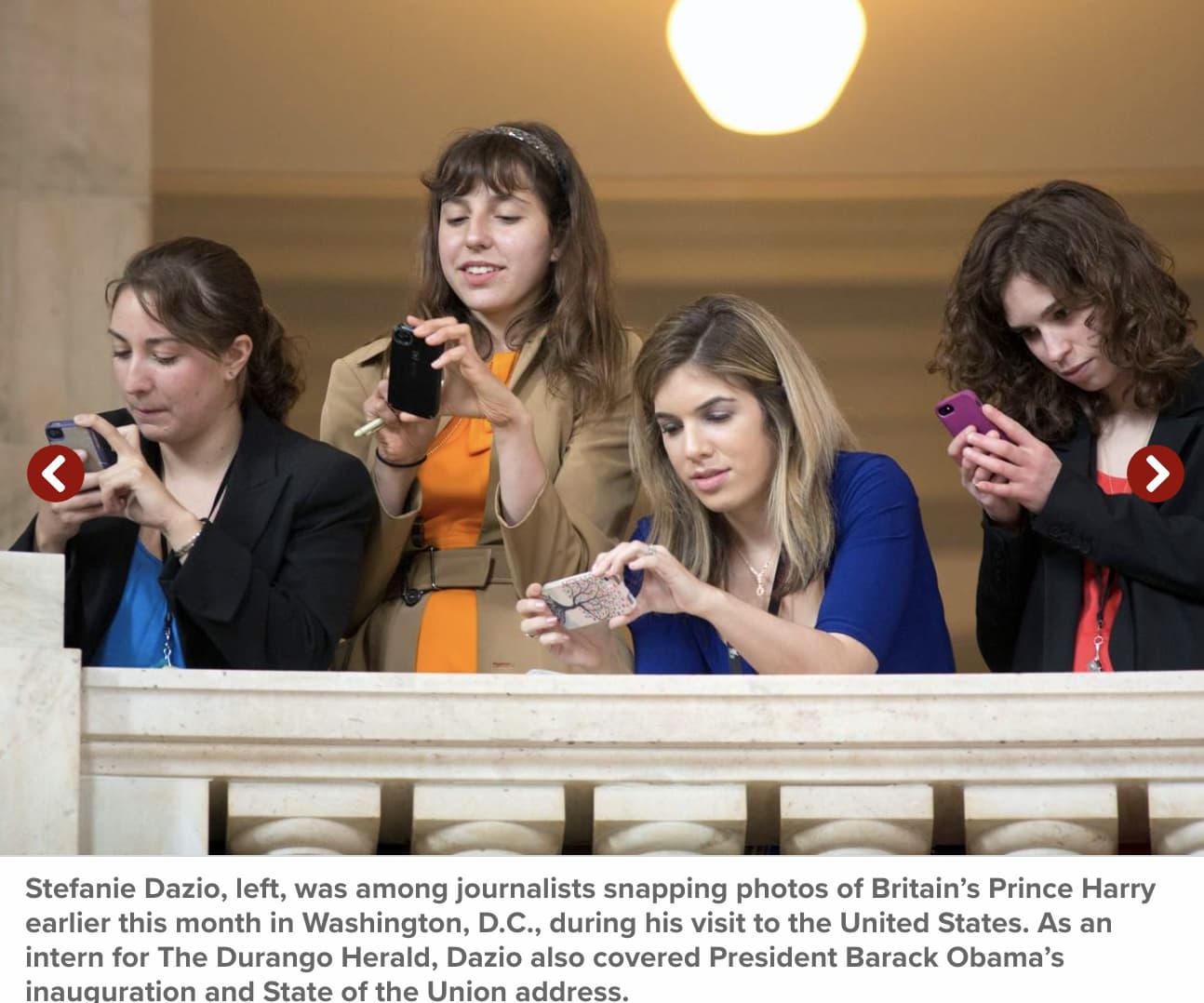
After graduation, Dazio was hired by Northern New Jersey’s well-respected Bergen Record, where she was told her experience gained during the Herald internship helped push her ahead of other applicants. She was the features and weekend news reporter before becoming the criminal justice reporter. After three-plus years there, she moved to Long Island’s Newsday Media Group as a municipal reporter and then the criminal justice reporter. After more than two and half years at Newsday, she was hired by The Associated Press to be the Crime and Law Enforcement Reporter in Los Angeles.
Don Lindley, managing editor of the Herald at the time, called Frantz’s and Dazio’s hustle, determination and persistence the “fire in the belly.” You don’t teach that, Lindley said. You just have it.
That’s life as an intern for the Durango Herald, a newspaper with a long history of family ownership and a legacy of strong journalism. Since this internship began 12 years ago, 34 journalism students from AU SOC have participated in the program. There is an intern each semester, including the summer. Each of those interns has a story to tell about their experience.
The relationship between the intern in Washington and editors in Durango, 1,900 miles away, is collaborative. Leading the team in Durango is Deputy Editor Shane Benjamin, who has been with the Herald as a reporter and city editor. Benjamin has an enormous amount of local, regional and statewide knowledge and works closely with the student journalists. An intern’s typical day is much like working any beat. A key component of that relationship is ongoing communication between the intern and the editors. It also is important to maintain regular contact with Colorado’s two U.S. senators, currently senior Sen. Michael Bennet and junior Sen. John Hickenlooper, and the representative for Colorado’s 3rd congressional district, Lauren Boebert. Interns are given assignments but also pitch their own story ideas.
On Aug. 5, 2015, a work crew supervised by the Environmental Protection Agency was doing exploratory work as a prelude to cleanup efforts at the long-abandoned Gold King Mine north of Silverton, Colorado, which sits at 9,300 feet in the San Juan Mountains. As the crew’s heavy machinery peeled back a layer of rock and dirt at the entrance to the mine, water began seeping out and quickly became a deluge, and 3 million gallons of toxic water surged down the mountain and into the pristine waters of the Animas River. The water flowed past Silverton and Durango and into New Mexico, where it joined the San Juan River through the Navajo Nation reservation. The Animas is famous for kayaking, whitewater rafting and world-class fly fishing. Quickly the emerald clear waters of the Animas turned a sickly yellow.
Edward Graham, an SOC graduate student studying journalism and public affairs, was the Herald intern in the fall of 2015. The Gold King Mine spill was still on everyone’s mind when Graham suggested to the editors that he do a six-month anniversary story focusing on the legislative responses in Congress. The editors liked Graham’s idea so much they decided to make it an entire staff project to focus on the spill’s impact on local, state and national levels. Graham researched mine remediation efforts being pursued in Congress. He set up interviews with Bennett, Tipton and Sen. Cory Gardner, a Republican who succeeded Udall. He also arranged an interview with Secretary of the Interior Ken Salazar, who was Bennet’s predecessor in the U.S. Senate. Graham, now a freelance writer and editor in Washington, was asked to extend his internship into the spring of 2016. Read stories by Graham
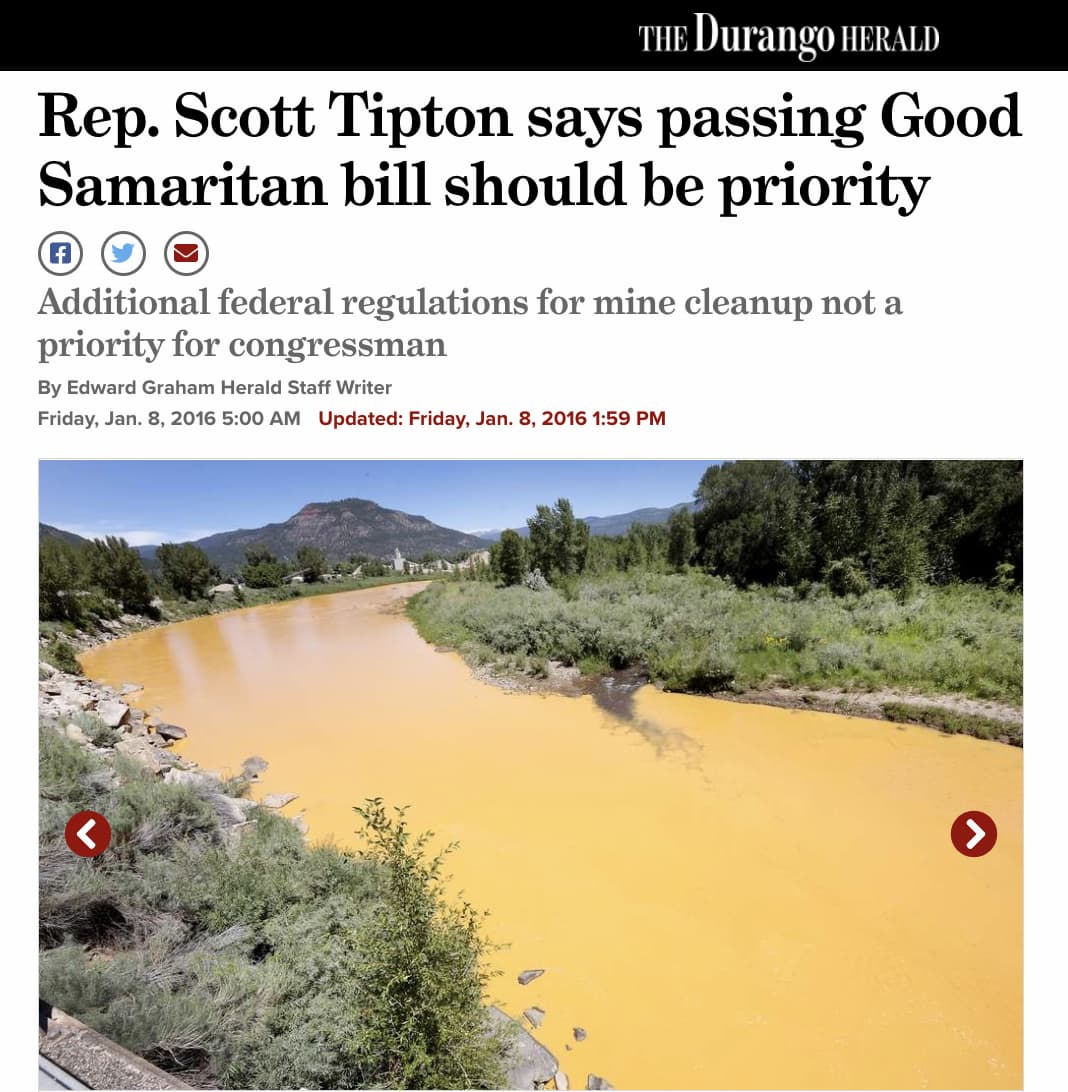
The goal of the internship is twofold. First, the internship provides journalism students with real-world experience covering members of Congress and the issues important to Herald readers. Second, the intern focuses on news and information readers would get only from a reporter based in the nation’s capital. As of this writing, the Durango Herald through this paid internship with AU, is the only newspaper in Colorado with, to borrow a phrase, boots on the ground in Washington, DC.
Interns often are in a position to provide details and insight into a national story that also is local to Colorado. Such was the case when Neil Gorsuch, a judge on the U.S. Court of Appeals for the 10th Circuit based in Denver, was nominated for the U.S. Supreme Court by President Donald Trump. Shira Stein, a sophomore majoring in journalism and biology at the time, and the Herald intern that spring in 2017, knew there was a story to be had. Not able to get an interview with Gorsuch, Stein did the next best thing and reached out to his friends, colleagues, former law clerks and others. The story Stein crafted from conversations with people who knew the judge well was an insightful profile. Richard Ballantine, long-time publisher and CEO of the Herald and key benefactor for the internship, had this assessment of Stein’s article:
“On Monday of this week Shira Stein's very thorough and well-shaped report about Neil Gorsuch's affability and love of the outdoors appeared,” Ballantine wrote in an email on March 25, 2017. “She quotes two of his former clerks, the boss of the Washington law firm where he worked, a clerk of another Supreme Court justice and a dean at the CU law school where Gorsuch has been teaching.
“Friendly jogging challenges, annual barbecues and ski trips all with past andcurrent clerks are included. Shira puts all this together in a very readable fashion. It's a model story.”
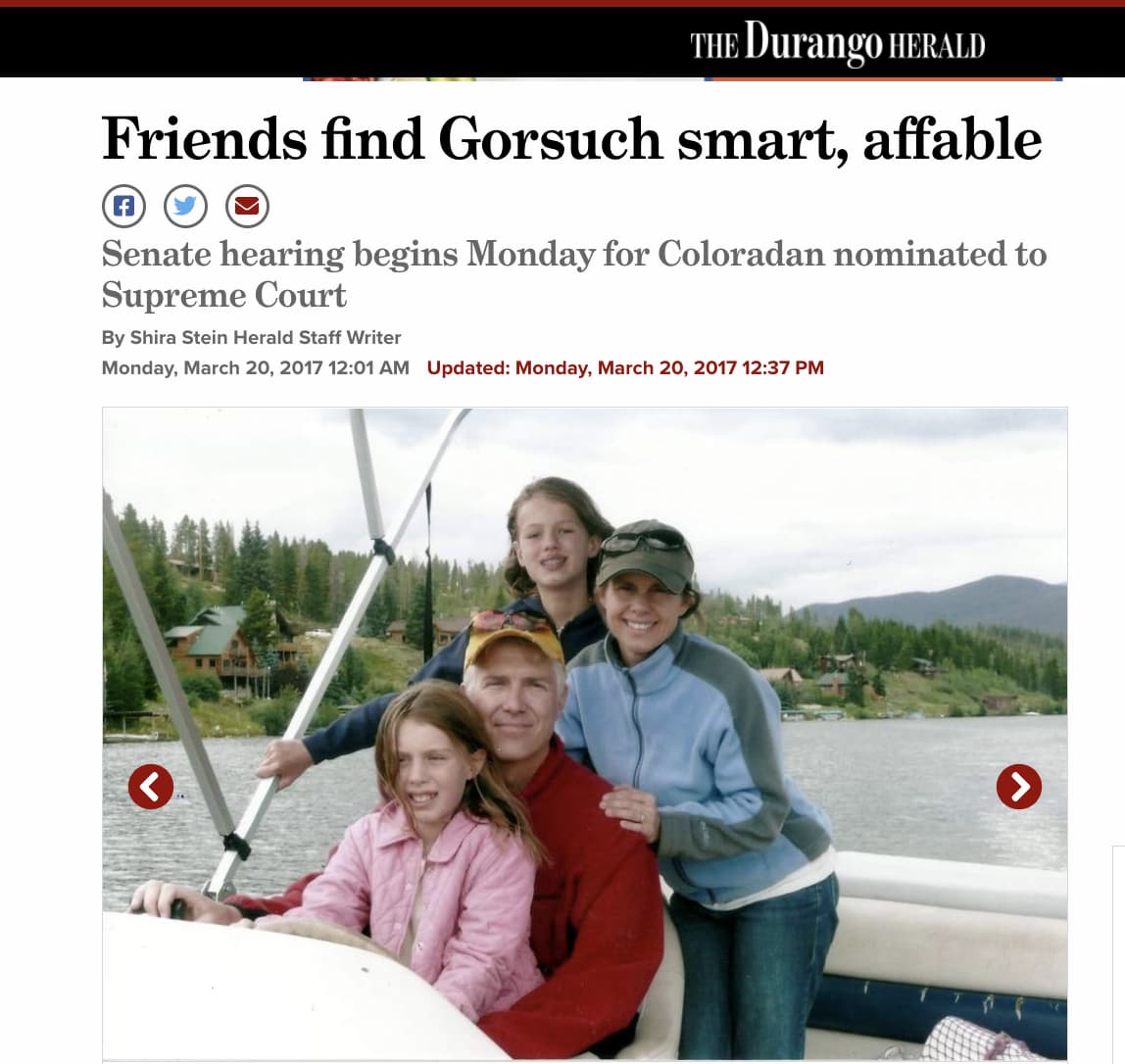
This internship had its beginning when two former USA Today colleague collaborated to bring a loosely formed idea to fruition. I was the longtime director of editorial operations at USA Today and retired in 2008 after 25 years with the newspaper. That same year, I was invited to join the board of directors of Ballantine Communications Inc., a family-owned media company based in Durango, that includes the Durango Herald, the Cortez Journal, two weekly newspapers, regional magazines and a collection of phone books that reached from southwest Colorado into New Mexico. Lynne Perri was a deputy managing editor at USA Today when she left to join the staff of AU’s School of Communication as a Journalist- in-Residence and later became Managing Editor of the Investigative Reporting Workshop, a nonprofit newsroom based at the School.
Every newspaper in Colorado, with the exception of the Denver Post, was relying on the Associated Press for news from Washington about important issues and relevant legislation along with coverage of the Congressional delegations from Colorado. The Herald had a reporter in Denver covering the statehouse, and I thought it would benefit readers if the Herald also had a reporter based in Washington. In the fall of 2009, I approached Ballantine with the concept of an internship and he embraced the idea, along with his belief that it should be a paid internship, an arrangement that was becoming rarer for newspapers.
I then reached out to Perri with the internship idea and we discussed possible options, including academic credit, but agreed on the paid internship.
We also discussed the parameters of the internship. Perri approached the school administration with the internship proposal and it was approved.
The final step was to contact the Senate Press Gallery for credentials. Joe Keenan, gallery superintendent at the time, said interns usually aren’t issued credentials, but he liked the idea and agreed to give it a try. For the spring semester of 2010, Jeremy Walsh became the first intern in the new partnership between the Herald and SOC. As the internship continued to be successful and with the urging of Perri, the SOC administration approved including the Herald in the elite portfolio of Dean’s Internships, which includes USA Today, Current, NBC4-Washington, Voice of America, NBC, CBS, NPR, the Washington Post and National Geographic. The Durango internship also includes a trip to Durango to meet the staff and learn about the area.
The Herald position often leads to other job possibilities. After her internship, Dazio had an internship in the Metro section of the Washington Post. Andrew Eversden, a junior majoring in journalism and political science, was the Herald intern in the spring 2018 when he wrote several stories involving Bennett, Gardner and Tipton. That experience contributed to his acceptance as a Reporting Fellow with the Texas Tribune. He currently is a staff reporter for Breaking Media, covering the Army for Breaking Defense. Following her Herald internship in the fall 2012, Leigh Giangreco was offered an investigative reporting internship with USA Today. She currently is a freelance reporter in Chicago.
This internship is made possible by the generosity and commitment to education of Richard and Mary Lyn Ballantine. The Herald has been a Ballantine family enterprise since Arthur and Morley Ballantine purchased the Herald Democrat and the Durango News in 1952. They merged the two newspapers and changed the name to The Herald-News. In 1960 the name permanently became the Durango Herald. The company grew and became Ballantine Communications Inc. with its portfolio of newspapers, magazines, phone and regional directories and digital media.
Education long has been a top priority for the Ballantine family. Arthur and Morley advocated for making the two-year Fort Lewis College into a four-year college and relocating it to Durango. Fort Lewis is a public liberal arts college serving a diverse student body. Richard Ballantine served on the college Board of Trustees and as a member of the college Foundation Board. The Ballantine family is a benefactor to The Center of Southwest Studies headquartered at Fort Lewis College, and Richard donated his significant collection of Native American weavings to the center.
The Ballantine family has a legacy of strong journalism and a commitment to government transparency, including open-records legislation. Richard Ballantine was inducted into the Colorado Press Association Hall of Fame, as was Morley Ballantine, his mother. Richard is a past president of the press association and received a Lifetime Achievement Award from the group.
Richard’s sister, Elizabeth, a lawyer, is director and co-owner of the company. She began her career as a reporter for the Des Moines Register. She has served on the board of The McClatchy Company, the board of the Inter American Press Association and the board of The International Center for Journalists.
Richard and Elizabeth are fourth-generation members of the Cowles family who owned several newspapers and magazines, including Look, a biweekly, general-interest publication.
The Ballantine family, through the Herald, has supported journalism programs in high schools throughout the area and the Herald Congressional Internship with the School of Communication at AU is a continuation of that commitment to journalism education.
To apply for an internship with The Durango Herald, submit applications through the Dean’s Internships website.
